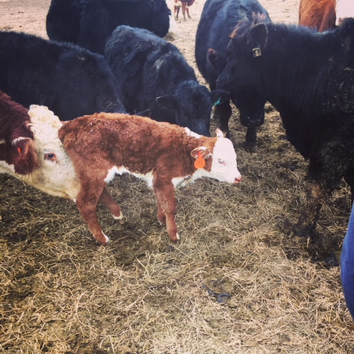 Our daughter is currently preparing for her class play on “mistakes and failures- and how we learn from them”. Pretty clever and insightful for 3rd grade, right? It got me thinking about mistakes I’ve made at the farm. While this blog post is nowhere long enough to list them all, I figured I shared the latest one in the spirit of Cecilia’s class play! As you may remember from a previous post, we have been narrowing our calving season to springtime only. We are shooting for our momma cows to deliver between April and June. At this point, the harsh winter has passed and the green has come back to our pastures- an ideal time and place to have a newborn calf! To make this happen, our fertile bulls have to be introduced into our cow heard by July, and be taken out by October. Cows have a 9-month gestation period, which gets us to the April- June calving window. All good so far… When our cows give birth they have a 50/50 chance of a male or female calf. Once the calf is born our only intervention for a female calf is dabbing her umbilical cord with some iodine to prevent infection. We do the same for the males, but we do one more thing for these guys- they need to be castrated. Our male readers may be wincing now, but the way we do this is the most humane. It’s a no snip procedure. We stretch a thick rubber band, the size of a toothpaste cap and insert the bull calves’ testicles and sack into the opening. The important part is to make sure BOTH testicles are below the rubber band when it closes. This method cuts off the blood flow below the rubber band and within a couple of weeks the area below the rubber band falls off. These (castrated) steers are where most of the cut beef comes from. With less testosterone than a bull, the steers are more docile, they can’t impregnate the cows out of season so they can stay with the herd, and their meat is more tender. Ok, now for the mistake… Rewind to late spring of 2017, and we noticed one of our steers getting “frisky” with the cows. I thought it was strange but, he doesn’t have any testicles so “no harm, no foul”. I was sure of this- I did the procedure myself! In the fall, when we moved the bulls out and prepared the herd for winter, we asked the Vet to check all the steers. Well much to my chagrin, this guy still had his “family jewels”! BUT… they were tucked way up high into his body. Having seen a fertility specialist myself, the doctors encourage human males to wear boxers as it keeps the boys away from the heat of our body… (heat reduces sperm count). So when the vet told me that I didn’t band him properly, my male memory jogged to the human doctor and boxer shorts and I told myself that “the bull/steer’s boys are too warm and his sperm wont work.” Man plans, nature laughs… It turns out that his sperm DID work and we had a couple of new calves just a few days ago in early March! I am a proud, happy grandpa, but with this mistake, I have just increased the layers of management on the farm. For the next month, we have to be extra vigilant watching for newborn calves. These calves have to be moved to a "maternity ward" or manger in the barnyard with their moms so they can stay warm, as the nights still dip into the teens and we have snow and ice. My daughter always called this particular bull “the Beer” (combo of bull and steer) because we thought it was funny he was mounting the cows. Well, “The Beer” will keep me from making that mistake again. Lesson learned! Posted by Paul.
0 Comments
Your comment will be posted after it is approved.
Leave a Reply. |
AuthorMarisa usually writes about nutrition, grass fed beef, organic agriculture, as well as sharing delicious recipes; Paul writes about farm work- sharing his stories and experiences, and most times... we both collaborate on the stories! Archives
March 2024
Categories
All
|
 RSS Feed
RSS Feed


